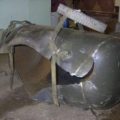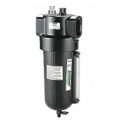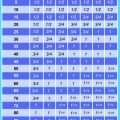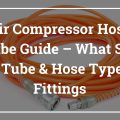Hey! This site is reader-supported and we earn commissions if you purchase products from retailers after clicking on a link from our site.
Compressed air is used in many different industries, with a lot of companies depending on compressed air to produce products as well as providing power to tools. It’s become so common that it is now considered a significant utility along with electricity, water, and natural gas.
The only downfall is the costs associated with using air compressors. And one fact which will shock you is that almost half of all compressed air produced across the world is wasted! This article will present to you all the relevant information on the costs associated with air compressors and compressed air.
Table of Contents
- Compressed Air Cost
- Air Compressor & Installation Cost
- Air Compressor Maintenance Cost
- Air Compressor Operation Cost
- Calculating Your Air Compressor Costs
- How to Reduce Air Compressor Costs
Compressed Air Cost
With the initial cost of an air compressor sometimes being big, and a one-off payment, this leads people to wrongly assume that once they’ve purchased the air compressor, the majority of the overall cost is covered. Well, this is so wrong!
You may not realize it because the electricity costs each month are so little, but over time the electricity costs accumulate to being far more expensive. It’s estimated by the U.S Department of Energy that the cost of using air compressors are as follows:
- Air Compressor & Installation: 12%
- Air Compressor Maintenance: 12%
- Air Compressor Operation (Electricity): 76%
Of course, industrial air compressors are going to consume a lot more electricity than small air compressors being used at home because they are operated far more often. These estimations are based on industrial use, your electricity bill from use at home will be significantly lower and so, these percentages will vary accordingly.
For reference, the assumptions in this estimation include a 75-hp compressor operating two shifts a day, 5 days a week at an aggregate electric rate of $0.05 kWh over 10 years of equipment life.
Now we’ll take a look into each of these in more depth!
Air Compressor & Installation Cost
The cost of compressor ownership varies substantially based on a number of criteria, not just the purchase price. It would be wise to know in advance all of the costs. Here is information about the many costs associated with compressor ownership.
Purchasing an air compressor is the biggest upfront cost, but as I’ve clearly shown, it’s not the biggest cost in the long run. Compressor buying trends indicate that for a general-purpose industrial air compressor up to 20 HP folks select a reciprocating unit which are lower-cost units than the rotary screw or rotary vane type compressors.
For more demanding industrial applications, and in a wide range of available horsepower, the rotary screw seems to be the next most popular type of industrial air compressor. The rotary vane, while still prominent, appears to be selected for specialty applications more often than the first two.
How dry and pure the air is can also affect the price of an air compressor, along with the equipment and costs of installation, they all add up. If your building or garage needs retrofitting to accommodate the new compressor, then you should factor this in.
Some new compressors will include if they’re eligible, energy efficiency rebates in their prices which will bring the cost of the equipment down.
If we ignore the time you spend on researching a compressor purchase, your first cost of compressor ownership is, of course, the purchase of your air compressor. What you are using your air compressor for, and the discharge flow rate and pressure needed for your applications will determine what size and type of compressor are required. See the pages on this site about buying an air compressor for help in determining what size compressor you need.
To guide you down that path in compressor buying, it’s good to know that the rule of thumb in the industry is that for compressors over 10HP in size, each motor horsepower can generate about 4 CFM of compressed air at 90 PSI.
Air Compressor Maintenance Cost
After purchasing or leasing the compressor, next on my compressor ownership cost list is the maintenance of the compressor. According to Energy Star data, maintenance and repairs make up about 12 percent of an air compressor’s life.
After the warranty period, who is going to fix the compressor when it goes down, because it will, eventually? Will it be your staff, the compressor supplier, or a third-party maintenance group? What are their labor costs, and what hours are expected to be consumed in both regular maintenance and emergency repairs? Not all compressor maintenance costs are the same, and so, it may be worth checking before selecting a compressor and comparing the maintenance costs down the line.
Included in the maintenance part of the equation is the cost of the spare parts for regular maintenance and parts costs for emergency repair.
The major compressor manufacturers will be able to provide a forecast of annual maintenance costs, the sum of which might help you decide to purchase a more expensive yet more reliable compressor. This will then, one would hope, provide you with lower compressor maintenance costs over the life of the unit.
One way to help reduce costs here is to conduct regular inspections and maintenance to avoid or decrease repairs. Setting up an inspection schedule, or preventative maintenance, and sticking to it can go a long way for preventing damage and then having to repair it.
Finding and repairing damage when it is minor can help you avoid more expensive and time-consuming damages to components further down the line. Of course, some parts of compressed air systems are more susceptible to damage than others, and so, you should pay more attention to these parts.
Common problems that are encountered are air leaks and damaged cylinders, rings, and bearings. Lubricating your equipment can help reduce the likelihood of damaged cylinders, rings, and bearings if applied correctly. Are leaks are common due to open condensate traps and shut-off valves, fittings, couplings, hoses, joints, thread sealants, disconnects, and pressure regulators.
We have the following pages available on our site regarding air compressor leaks:
- Compressed Air Leaks
- How To Fix An Air Compressor Tank Leak
- How To Fix A Leaky Air Compressor Hose
- Air Compressor Quick Connect Leaks
Air Compressor Operation Cost
One expense that will ultimately overwhelm all other cost considerations for most industrial compressor applications is the cost of operating that compressor. Even for DIYers, the electricity bill will add up over time. The operating of an air compressor is usually more expensive than purchasing one.
As Energy Star estimate in their example, 76% of the lifetime cost of an industrial air compressor is its electricity. They say that over a 10 year period of operation, a typical industrial air compressor can accumulate up to $800,000 in electricity costs, wow!
Of course, there are many factors that will impact the cost of using an air compressor. This includes how long you’re running it and the cost of electricity in your area. Some air compressors are more energy-efficient than others, and so, they will cost less to operate. That’s why it’s so important to consider these costs when selecting the right air compressor for you.
Since the vast majority of industrial air compressors in plants run on electricity, the details below will help you determine the operating cost of the unit you are considering purchasing.
There are many formulas available to help determine your operating costs. We will offer a simplified version. If you seek greater detail a couple of sources are noted below for you as well.
Calculating Your Air Compressor Costs
To calculate your air compressor costs, you will need the following:
- Electricity costs per kWh
- Hp of your compressor
- Compressor annual run time
- Efficiency of the motor
- Conversion factor: hp to kw = 0.746
- Load factor
Reference finding the electricity costs per kWh, if you do not pay the bills at your company, ask the accounts payable person to check on your last company hydro bill. Make sure that delivery costs, etc. are included in the kWh amount.
Annual run time is the number of hours per day, times number of days per week, times 52 weeks a year, resulting in a number of hours per year.
Motor efficiency information should be available from the compressor manufacturer. In the absence of that information, work on the basis of 90% efficiency or see if this information is noted on the compressor motor plate.
If your compressor runs all the time, and only compresses air part of the time, the time it is actually compressing air is the load factor. When it is running unloaded, the motor will use less energy.
If you are contemplating a compressor that only runs when it is compressing air, the load factor would be 1. If in doubt, use a load factor of 0.8. That should suffice for most applications. Here’s what the simple formula to calculate your compressor operating cost looks like:

Let’s throw a few numbers at it, shall we? Next is a chart with the numbers for our theoretical compressor application, from which you may be able to extrapolate costs to your compressor of choice to determine the operating cost.
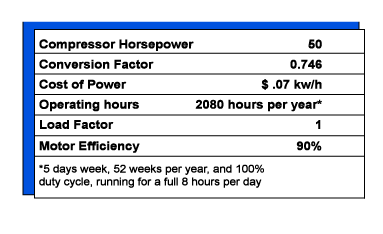
Here’s the formula referred to earlier, now with our theoretical application numbers plugged into the formula.

When you do the math, you’ll see that this 50 HP compressor, will cost $4,887.00 per year in energy operating costs! Today, an electricity cost of $0.12/kWh to $0.20/kWh or more may be more appropriate. At $0.12/kWh, this compressor will cost about $10,000 per year to run, based on the hours of use shown in the example. This calculating is just to give you an idea, research the cost of energy in your area and apply it to this formula!
Use this method of calculating a compressor operating cost and then compare that to the purchase price of the air compressor. And see how important compressor operation costs are to know upfront!
Here’s a YouTube demonstration of an alternative method for calculating the real life cycle cost of a rotary screw air compressor:
How to Reduce Air Compressor Costs
I know you must be really interested in reducing operating costs by now! You’ll want to know that typically more than 10% of a compressor’s compressed air output is wasted through folks using your air for other than its desired use, or leaked from your system. Save significant costs every year by curtailing air waste, and ridding your plant of air leaks.
Use leak detector equipment to find and stop air leaks on a regular basis. The payback can be substantial. It is possible to provide a significant amount of heat for your plant from your compressor. Since you want the air going into your plant to be as cool as possible, a heat exchanger/aftercooler might be a way to recapture the compressor heat for reuse.
Some great techniques to help you save energy on using air compressors include:
- Purchasing an energy-efficient air compressor
- Turning off your air compressor when it’s not in use
- Using only the required air pressure
- Changing filters regularly
- Conducting air leak checks regularly
- Carrying out preventative maintenance
- Reclaiming compressed air
Purchasing an Energy-Efficient Air Compressor
Most modern-day air compressors are far more energy-efficient than older generations due to their better offering of control. When selecting an air compressor, look for one with energy-efficient flow control and storage systems.
Flow control systems can sense downstream pressure and react to small changes which will greatly help reduce your compressed air waste. The greater the air compressor’s storage capacity, the less time the air compressor will need to run. For anyone operating air compressors frequently, it’s worth considering having an increased storage capacity to save a significant amount of electricity per year.
Turning Off Your Air Compressor When it’s Not in Use
Whenever you’re not using your air compressor, turn it off! Too many people or businesses leave their air compressors on when they’re not in use, whether that’s after hours or during the weekend. Compressors that are on constantly can use a significant amount of electricity, even if you’re not using them, they may cycle on and off to maintain pressure due to a tiny air leak you were unaware of.
Getting into the habit of turning your air compressor off when it’s not in use can help you to reduce your electricity bills by up to 20 percent!
Using Only the Required Air Pressure
It’s common for air compressor users to compensate for air leaks or pressure drops across components and lengths of pipe by raising the pressure and then regulating it at the end-use. But, doing so will cause you to spend more money on electricity.
It’s estimated that around 5% more energy is used to produce additional pressures of 10 PSI. If you don’t need the additional pressure, don’t use it!
Change Filters Regularly
Changing your filters regularly can also help reduce electricity costs. Clogged or dirty filters are liable to cause an air compressor motor to overwork in order to provide the appropriate PSI. Cleaning your filter can reduce the cost of maintenance and air leaks.
If the filter is not working properly, contaminants will pass through and potentially cause damage to your piping system, corroding the insides and leading to potential air leaks. Replacing compressor filters immediately will help to reduce the likelihood of expensive repairs.
Conducting Air Leak Checks Regularly
Finding air leaks can help reduce a significant amount of energy in your compressed air system, potentially equating to thousands of dollars a day in big industrial practices. To conduct a successful leak audit you will need knowledge, planning, and follow-through.
Ensure that you, or the technician, understand the air compressor’s technical specifications, and how to inspect the full compressed air system. You must plan a regular time to inspect the system, and when you do, tag/mark or take pictures of any leaks for repair. When the inspection is complete, make sure all marked areas have been repaired.
Prioritize the biggest leaks as these areas will be responsible for the biggest waste of energy.
Carrying Out Preventative Maintenance
By conducting small and regular maintenance, you can prevent the need to conduct larger, time and cost-consuming repairs. To do so, make sure that components are operating optimally.
If compressors get too hot, breakdowns and costly repairs become more likely. If compressed air systems have aftercoolers installed, check these to make sure components like the fins aren’t clogged.
For more information on this and the steps to take, visit our Air Compressor Maintenance – Preventative & Ongoing guide!
Reclaiming Compressed Air
In some situations, mostly industrial settings, it’s possible to use the heat produced by the air compressor and recirculate it to heat the building. Of course, this isn’t simple, as you’ll need to have ducting installed to connect the compressor to the area you wish to heat. But, it is another effective way to reduce your overall electricity costs, as you will reduce the need for additional heating.
If you have any questions regarding typical air compressor costs, please leave a comment below, with a photo if applicable, so that someone can help you!

